FORECASTING TIME SERIES AND REGRESSION
- 格式:ppt
- 大小:2.85 MB
- 文档页数:32
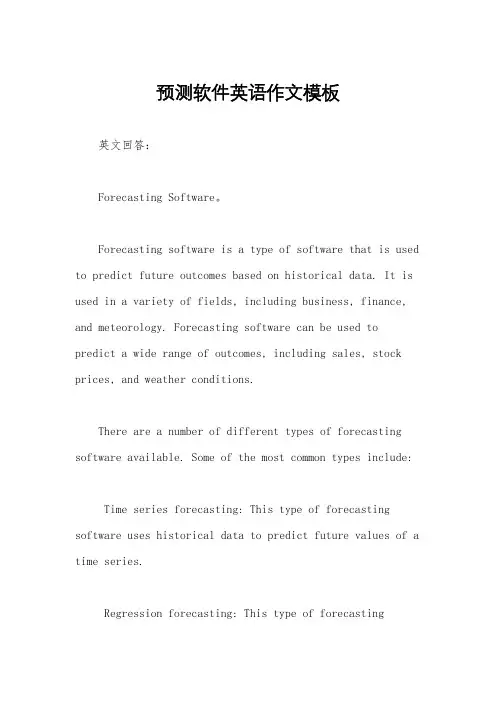
预测软件英语作文模板英文回答:Forecasting Software。
Forecasting software is a type of software that is used to predict future outcomes based on historical data. It is used in a variety of fields, including business, finance, and meteorology. Forecasting software can be used topredict a wide range of outcomes, including sales, stock prices, and weather conditions.There are a number of different types of forecasting software available. Some of the most common types include:Time series forecasting: This type of forecasting software uses historical data to predict future values of a time series.Regression forecasting: This type of forecastingsoftware uses a regression model to predict therelationship between a dependent variable and one or more independent variables.Machine learning forecasting: This type of forecasting software uses machine learning algorithms to predict future outcomes.Forecasting software can be a valuable tool for businesses and organizations. It can help them to make better decisions about the future by providing them with accurate predictions of future outcomes.中文回答:预测软件。

《Business Analytics》教学大纲(一)课程地位The aim of this module is to build and developed students9 understanding and application of mathematics and statistics, appropriate for business disciplines at the undergraduate level. The module begins by reviewing various techniques for collecting and presenting data. Some important measures and techniques for making sense of raw data are then introduced which are widely used by businesses when analysing both their internal and external environments.This module supports a range of numerical skills and techniques commonly developed within the modules "Introduction to Accounting and Finance,, and "Foundations of Finance^^ both in a theoretical manner and a practical approach through the use of Microsoft Excel. This module also provides mathematics and statistics skills which are integral to the business finance and economics modules which students will take in future semesters as part of their ongoing development. Students will be helped to develop further their hands-on skills in using Microsoft Excel in computer workshops to handle both small and large business data. This is considered to be an appropriate approach to learning in which relevant statistical techniques and methods will be explored in a practice based manner in keeping with that of other business and finance modules where possible.Careful attention will also be paid throughout the module to the interpretation and application of the various quantitative methods and techniques to the solution of real-world business problems.(二)课程目标This module, like all modules at Anglia Ruskin, is taught on the basis of achieving intended learning outcomes. On successful completion of the module, the student will be expected to be able to demonstrate the following:Knowledgeand LO 1.Identify and assess the usefulness of key numerical,understanding graphical and statistical indicators of business activity.LO 2.Demonstrate an awareness of how these variousquantitative indicators can be used by businesses tobetter inform their decision making affective and transferableskillsIntellectual, practical, LO 3. Apply statistical packages and spreadsheets to support theThe assessment is based on meeting these learning outcomes, shown explicitly in section 4, where the assessment task is linked to these learning outcomes.二、课程目标达成的途径与方法课程目标达成的途径主要通过课堂教学,辅以课外作业的形式。
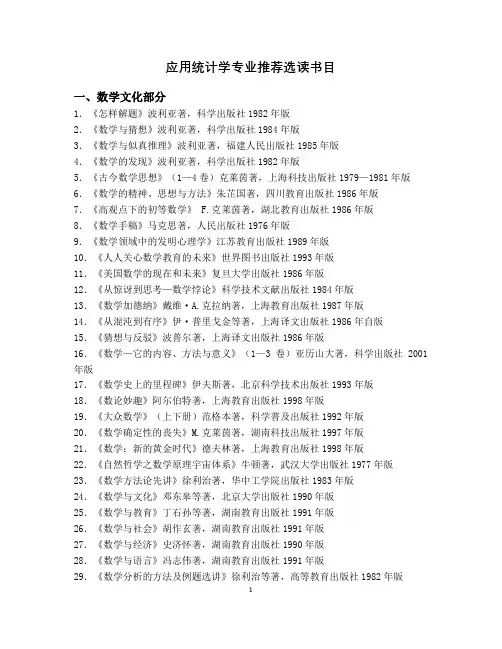
应用统计学专业推荐选读书目一、数学文化部分1.《怎样解题》波利亚著,科学出版社1982年版2.《数学与猜想》波利亚著,科学出版社1984年版3.《数学与似真推理》波利亚著,福建人民出版社1985年版4.《数学的发现》波利亚著,科学出版社1982年版5.《古今数学思想》(1—4卷)克莱茵著,上海科技出版社1979—1981年版6.《数学的精神、思想与方法》朱芷国著,四川教育出版社1986年版7.《高观点下的初等数学》 F.克莱茵著,湖北教育出版社1986年版8.《数学手稿》马克思著,人民出版社1976年版9.《数学领域中的发明心理学》江苏教育出版社1989年版10.《人人关心数学教育的未来》世界图书出版社1993年版11.《美国数学的现在和未来》复旦大学出版社1986年版12.《从惊讶到思考—数学悖论》科学技术文献出版社1984年版13.《数学加德纳》戴维·A.克拉纳著,上海教育出版社1987年版14.《从混沌到有序》伊·普里戈金等著,上海译文出版社1986年自版15.《猜想与反驳》波普尔著,上海译文出版社1986年版16.《数学—它的内容、方法与意义》(1—3卷)亚历山大著,科学出版社2001年版17.《数学史上的里程碑》伊夫斯著,北京科学技术出版社1993年版18.《数论妙趣》阿尔伯特著,上海教育出版社1998年版19.《大众数学》(上下册)范格本著,科学普及出版社1992年版20.《数学确定性的丧失》M.克莱茵著,湖南科技出版社1997年版21.《数学:新的黄金时代》德夫林著,上海教育出版社1998年版22.《自然哲学之数学原理宇宙体系》牛顿著,武汉大学出版社1977年版23.《数学方法论先讲》徐利治著,华中工学院出版社1983年版24.《数学与文化》邓东皋等著,北京大学出版社1990年版25.《数学与教育》丁石孙等著,湖南教育出版社1991年版26.《数学与社会》胡作玄著,湖南教育出版社1991年版27.《数学与经济》史济怀著,湖南教育出版社1990年版28.《数学与语言》冯志伟著,湖南教育出版社1991年版29.《数学分析的方法及例题选讲》徐利治等著,高等教育出版社1982年版30.《数学思想发展简史》袁小明等著,高等教育出版社1992年版31.《从数学教育到教育数学》井中等著,四川教育出版社1989年版32.《几何中机器证明的基本定律》吴文俊著,科学出版社1984年版33.《21世纪数学展望》江苏教育出版社1992年版34.《中国数学通史》李迪著,辽宁教育出版社1997年版35.《世界数学通史》梁宗巨著,辽宁教育出版社1995年版36.《九章算术》辽宁教育出版社2000年版37.《华罗庚》王元著,开明出版社1994年版38.《数:上帝的宠物》谈祥柏著,上海教育出版社1998年版39.《科学发现纵横谈》王梓坤著,湖南教育出版社1979年版40.《科学发现纵横新编》王梓坤著,北京师范大学出版社1992年版41.《中国数学史》钱金琛著,科学出版社1992年版42.《现代数学设计论》盛群力等编,浙江教育出版社1998年版43.《混沌控制》胡岗著,上海科技出版社2000年版44.《Mathcad7.0实用教程》思索著,人民邮电出版社1998年版45.《Matlab应用程序接口用户指南》刘志俭著,科学出版社2000年版46.《数学奇妙》西奥妮.帕帕著,上海科技出版社1999年版47.《数学的源与流》张顺燕著,高等教育出版社2000年版48.《世界著名数学家评传》袁小明著,江苏教育出版社1990年版50.《古今数学思想》(1-4 册),M. 克莱因,北京大学译,上海科学技术出版社, 1979-198151.《数学 -- 它的内容、方法和意义》( 1-3 卷),亚历山大洛夫等,科学出版社, 1958--196252.《数学史概论》, H. 伊夫斯,欧阳绛译,山西人民出版社, 198653.《中国数学简史》,中外数学简史编写组,山东教育出版社, 198654.《外国数学史讲义》(上),张洪光,赣南师院数学系讲义, 198355.《数学简史》,冯长彬,赣南师院数学与计算机系, 199156.《数学史教程》,李文林编著,高等教育出版社, 1999二、统计学基础部分57.《统计学》 David Freedman等著,魏宗舒、施锡铨等译,中国统计出版社。
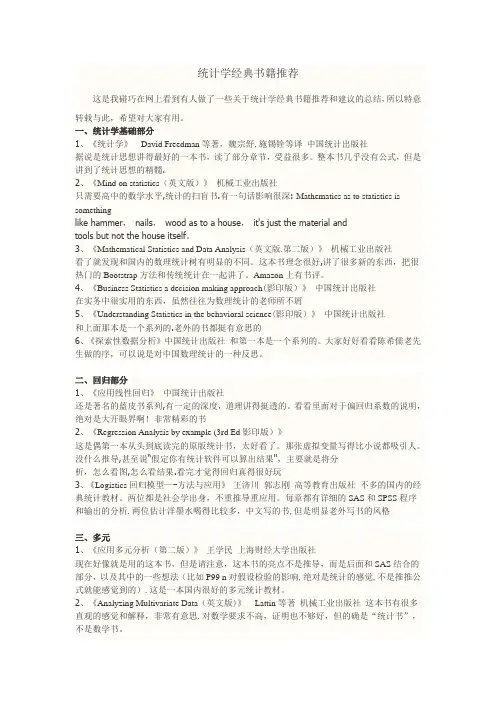
统计学经典书籍推荐这是我碰巧在网上看到有人做了一些关于统计学经典书籍推荐和建议的总结,所以特意转载与此,希望对大家有用。
一、统计学基础部分1、《统计学》David Freedman等著,魏宗舒,施锡铨等译中国统计出版社据说是统计思想讲得最好的一本书,读了部分章节,受益很多。
整本书几乎没有公式,但是讲到了统计思想的精髓.2、《Mind on statistics(英文版)》机械工业出版社只需要高中的数学水平,统计的扫盲书.有一句话影响很深: Mathematics as to statistics is somethinglike hammer,nails,wood as to a house,it's just the material andtools but not the house itself。
3、《Mathematical Statistics and Data Analysis(英文版.第二版)》机械工业出版社看了就发现和国内的数理统计树有明显的不同。
这本书理念很好,讲了很多新的东西,把很热门的Bootstrap方法和传统统计在一起讲了。
Amazon上有书评。
4、《Business Statistics a decision making approach(影印版)》中国统计出版社在实务中很实用的东西,虽然往往为数理统计的老师所不屑5、《Understanding Statistics in the behavioral science(影印版)》中国统计出版社和上面那本是一个系列的.老外的书都挺有意思的6、《探索性数据分析》中国统计出版社和第一本是一个系列的。
大家好好看看陈希儒老先生做的序,可以说是对中国数理统计的一种反思。
二、回归部分1、《应用线性回归》中国统计出版社还是著名的蓝皮书系列,有一定的深度,道理讲得挺透的。
看看里面对于偏回归系数的说明,绝对是大开眼界啊!非常精彩的书2、《Regression Analysis by example (3rd Ed影印版)》这是偶第一本从头到底读完的原版统计书,太好看了。
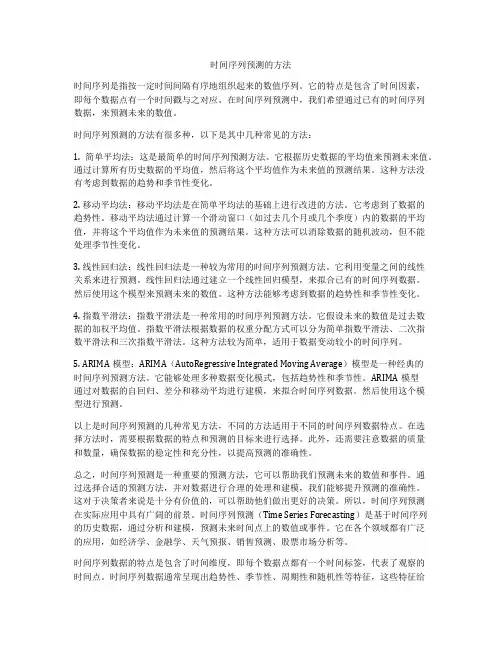
时间序列预测的方法时间序列是指按一定时间间隔有序地组织起来的数值序列。
它的特点是包含了时间因素,即每个数据点有一个时间戳与之对应。
在时间序列预测中,我们希望通过已有的时间序列数据,来预测未来的数值。
时间序列预测的方法有很多种,以下是其中几种常见的方法:1. 简单平均法:这是最简单的时间序列预测方法。
它根据历史数据的平均值来预测未来值。
通过计算所有历史数据的平均值,然后将这个平均值作为未来值的预测结果。
这种方法没有考虑到数据的趋势和季节性变化。
2. 移动平均法:移动平均法是在简单平均法的基础上进行改进的方法。
它考虑到了数据的趋势性。
移动平均法通过计算一个滑动窗口(如过去几个月或几个季度)内的数据的平均值,并将这个平均值作为未来值的预测结果。
这种方法可以消除数据的随机波动,但不能处理季节性变化。
3. 线性回归法:线性回归法是一种较为常用的时间序列预测方法。
它利用变量之间的线性关系来进行预测。
线性回归法通过建立一个线性回归模型,来拟合已有的时间序列数据。
然后使用这个模型来预测未来的数值。
这种方法能够考虑到数据的趋势性和季节性变化。
4. 指数平滑法:指数平滑法是一种常用的时间序列预测方法。
它假设未来的数值是过去数据的加权平均值。
指数平滑法根据数据的权重分配方式可以分为简单指数平滑法、二次指数平滑法和三次指数平滑法。
这种方法较为简单,适用于数据变动较小的时间序列。
5. ARIMA模型:ARIMA(AutoRegressive Integrated Moving Average)模型是一种经典的时间序列预测方法。
它能够处理多种数据变化模式,包括趋势性和季节性。
ARIMA模型通过对数据的自回归、差分和移动平均进行建模,来拟合时间序列数据。
然后使用这个模型进行预测。
以上是时间序列预测的几种常见方法,不同的方法适用于不同的时间序列数据特点。
在选择方法时,需要根据数据的特点和预测的目标来进行选择。
此外,还需要注意数据的质量和数量,确保数据的稳定性和充分性,以提高预测的准确性。
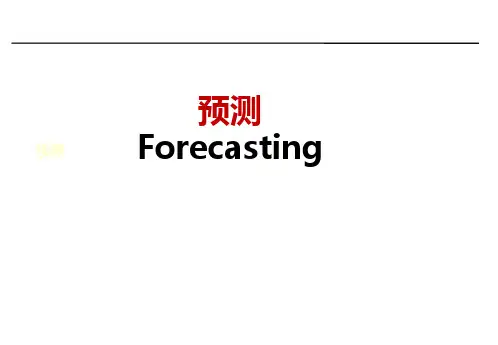

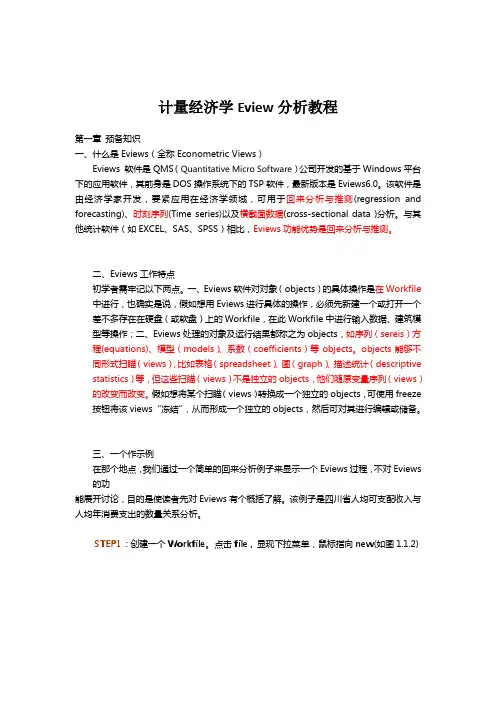
计量经济学Eview分析教程第一章预备知识一、什么是Eviews(全称Econometric Views)Eviews 软件是QMS(Quantitative Micro Software)公司开发的基于Windows平台下的应用软件,其前身是DOS操作系统下的TSP软件,最新版本是Eviews6.0。
该软件是由经济学家开发,要紧应用在经济学领域,可用于回来分析与推测(regression and forecasting)、时刻序列(Time series)以及横截面数据(cross-sectional data )分析。
与其他统计软件(如EXCEL、SAS、SPSS)相比,Eviews功能优势是回来分析与推测。
二、Eviews工作特点初学者需牢记以下两点。
一、Eviews软件对对象(objects)的具体操作是在Workfile 中进行,也确实是说,假如想用Eviews进行具体的操作,必须先新建一个或打开一个差不多存在在硬盘(或软盘)上的Workfile,在此Workfile中进行输入数据、建筑模型等操作;二、Eviews处理的对象及运行结果都称之为objects,如序列(sereis)方程(equations)、模型(models)、系数(coefficients)等objects。
objects能够不同形式扫瞄(views),比如表格(spreadsheet)、图(graph)、描述统计(descriptive statistics)等,但这些扫瞄(views)不是独立的objects,他们随原变量序列(views)的改变而改变。
假如想将某个扫瞄(views)转换成一个独立的objects,可使用freeze 按钮将该views“冻结”,从而形成一个独立的objects,然后可对其进行编辑或储备。
三、一个作示例在那个地点,我们通过一个简单的回来分析例子来显示一个Eviews过程,不对Eviews 的功能展开讨论,目的是使读者先对Eviews有个概括了解。
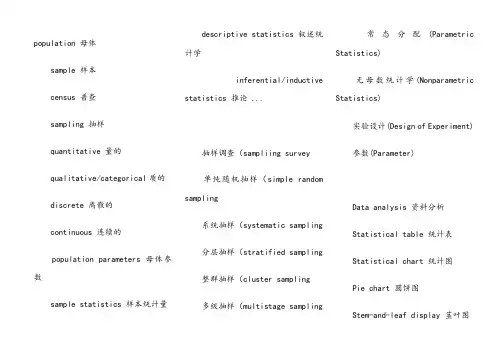
population 母体sample 样本census 普查sampling 抽样quantitative 量的qualitative/categorical质的discrete 离散的continuous 连续的population parameters 母体参数sample statistics 样本统计量descriptive statistics 叙述统计学inferential/inductivestatistics 推论 ...抽样调查(sampliing survey单纯随机抽样(simple randomsampling系统抽样(systematic sampling分层抽样(stratified sampling整群抽样(cluster sampling多级抽样(multistage sampling常态分配(ParametricStatistics)无母数统计学(NonparametricStatistics)实验设计(Design of Experiment)参数(Parameter)Data analysis 资料分析Statistical table 统计表Statistical chart 统计图Pie chart 圆饼图Stem-and-leaf display 茎叶图Box plot 盒须图Histogram 直方图Bar Chart 长条图Polygon 次数多边图Ogive 肩形图Descriptive statistics 叙述统计学Expectation 期望值Mode 众数Mean 平均数Variance 变异数Standard deviation 标准差Standard error 标准误Covariance matrix 共变异数矩阵Inferential statistics 推论统计学Point estimation 点估计Interval estimation 区间估计Confidence interval 信赖区间Confidence coefficient 信赖系数Testing statistical hypothesis统计假设检定Regression analysis 回归分析Analysis of variance 变异数分析Correlation coefficient 相关系数Sampling survey 抽样调查Census 普查Sampling 抽样Reliability 信度Validity 效度Sampling error 抽样误差Non-sampling error 非抽样误差Random sampling 随机抽样Simple random sampling 简单随机抽样法Stratified sampling 分层抽样法Cluster sampling 群集抽样法Systematic sampling 系统抽样法Two-stage random sampling 两段随机抽样法Convenience sampling 便利抽样Quota sampling 配额抽样Snowball sampling 雪球抽样Nonparametric statistics 无母数统计The sign test 等级检定Wilcoxon signed rank tests 魏克森讯号等级检定Wilcoxon rank sum tests 魏克森等级和检定Run test 连检定法Discrete uniform densities 离散的均匀密度Binomial densities 二项密度Hypergeometric densities 超几何密度Poisson densities 卜松密度Geometric densities 几何密度Negative binomial densities 负二项密度Continuous uniform densities连续均匀密度Normal densities 常态密度Exponential densities 指数密度Gamma densities 伽玛密度Beta densities 贝他密度Multivariate analysis 多变量分析Principal components 主因子分析Discrimination analysis 区别分析Cluster analysis 群集分析Factor analysis 因素分析Survival analysis 存活分析Time series analysis 时间序列分析Linear models 线性模式Quality engineering 品质工程Probability theory 机率论Statistical computing 统计计算Statistical inference 统计推论Stochastic processes 随机过程Decision theory 决策理论Discrete analysis 离散分析Mathematical statistics 数理统计统计学 : Statistics母体 : Population样本 : Sample资料分析 : Data analysis统计表 : Statistical table统计图 : Statistical chart圆饼图 : Pie chart茎叶图 : Stem-and-leaf display盒须图 : Box plot直方图 : Histogram长条图 : Bar Chart次数多边图 : Polygon肩形图 : Ogive叙述统计学: Descriptive statistics期望值 : Expectation众数 : Mode平均数 : Mean变异数 : Variance标准差 : Standard deviation标准误 : Standard error共变异数矩阵: Covariancematrix推论统计学: Inferentialstatistics点估计 : Point estimation区间估计 : Interval estimation信赖区间 : Confidence interval信赖系数: Confidencecoefficient统计假设检定: Testingstatistical hypothesis回归分析 : Regression analysis变异数分析: Analysis ofvariance相关系数: Correlationcoefficient抽样调查 : Sampling survey普查 : Census抽样 : Sampling信度 : Reliability效度 : Validity抽样误差 : Sampling error非抽样误差: Non-sampling error随机抽样 : Random sampling简单随机抽样法 : Simple random sampling分层抽样法: Stratified sampling群集抽样法 : Cluster sampling系统抽样法: Systematicsampling两段随机抽样法: Two-stagerandom sampling便利抽样: Conveniencesampling配额抽样 : Quota sampling雪球抽样 : Snowball sampling无母数统计: Nonparametricstatistics等级检定 : The sign test魏克森讯号等级检定 : Wilcoxonsigned rank tests魏克森等级和检定 : Wilcoxonrank sum tests连检定法 : Run test离散的均匀密度: Discreteuniform densities二项密度 : Binomial densities超几何密度 : Hypergeometricdensities卜松密度 : Poisson densities几何密度 : Geometric densities负二项密度 : Negative binomial densities连续均匀密度: Continuous uniform densities常态密度 : Normal densities指数密度: Exponential densities伽玛密度 : Gamma densities贝他密度 : Beta densities多变量分析: Multivariateanalysis主因子分析: Principalcomponents区别分析: Discriminationanalysis群集分析 : Cluster analysis因素分析 : Factor analysis存活分析 : Survival analysis时间序列分析: Time seriesanalysis线性模式 : Linear models品质工程 : Quality engineering机率论 : Probability theory统计计算: Statisticalcomputing统计推论: Statisticalinference随机过程: Stochasticprocesses决策理论 : Decision theory离散分析 : Discrete analysis数理统计: Mathematical statistics统计名词市调辞典众数(Mode) 普查(census)指数(Index) 问卷(Questionnaire)中位数(Median) 信度(Reliability)百分比(Percentage) 母群体(Population)信赖水准(Confidence level) 观察法(Observational Survey)假设检定(Hypothesis Testing)综合法(Integrated Survey)卡方检定(Chi-square Test) 雪球抽样(Snowball Sampling)差距量表(Interval Scale) 序列偏差(Series Bias)类别量表(Nominal Scale) 次级资料(Secondary Data)顺序量表(Ordinal Scale) 抽样架构(Sampling frame)比率量表(Ratio Scale) 集群抽样(Cluster Sampling)连检定法(Run Test) 便利抽样(Convenience Sampling)符号检定(Sign Test) 抽样调查(Sampling Sur)算术平均数(Arithmetic Mean)非抽样误差(non-sampling error)展示会法(Display Survey)调查名词准确效度(Criterion-Related Validity)元素(Element) 邮寄问卷法(MailInterview)样本(Sample) 信抽样误差(Sampling error)效度(Validity) 封闭式问题(Close Question)精确度(Precision) 电话访问法(Telephone Interview)准确度(Validity) 随机抽样法(Random Sampling)实验法(Experiment Survey)抽样单位(Sampling unit) 资讯名词市场调查(Marketing Research) 决策树(Decision Trees)容忍误差(Tolerated erro) 资料采矿(Data Mining)初级资料(Primary Data) 时间序列(Time-Series Forecasting)目标母体(Target Population)回归分析(Regression)抽样偏差(Sampling Bias) 趋势分析(Trend Analysis)抽样误差(sampling error) 罗吉斯回归(Logistic Regression)架构效度(Construct Validity)类神经网络(Neural Network)配额抽样(Quota Sampling) 无母数统计检定方法(Non-ParametricTest)人员访问法(Interview) 判别分析法(Discriminant Analysis)集群分析法(cluster analysis)规则归纳法(Rules Induction)内容效度(Content Validity) 判断抽样(Judgment Sampling)开放式问题(Open Question)OLAP(Online Analytical Process)分层随机抽样(StratifiedRandom sampling) 资料仓储(DataWarehouse)非随机抽样法(NonrandomSampling) 知识发现(KnowledgeDiscoveryAbsolute deviation, 绝对离差Absolute number, 绝对数Absolute residuals, 绝对残差Acceleration array, 加速度立体阵Acceleration in an arbitrary direction, 任意方向上的加速度Acceleration normal, 法向加速度Acceleration space dimension, 加速度空间的维数Acceleration tangential, 切向加速度Acceleration vector, 加速度向量Acceptable hypothesis, 可接受假设Accumulation, 累积Accuracy, 准确度Actual frequency, 实际频数Adaptive estimator, 自适应估计量Addition, 相加Addition theorem, 加法定理Additive Noise, 加性噪声Additivity, 可加性Adjusted rate, 调整率Adjusted value, 校正值Admissible error, 容许误差Aggregation, 聚集性Alpha factoring,α因子法Alternative hypothesis, 备择假设Among groups, 组间Amounts, 总量Analysis of correlation, 相关分析Analysis of covariance, 协方差分析Analysis Of Effects, 效应分析Analysis Of Variance, 方差分析Analysis of regression, 回归分析Analysis of time series, 时间序列分析Analysis of variance, 方差分析Angular transformation, 角转换ANOVA (analysis of variance), 方差分析ANOVA Models, 方差分析模型ANOVA table and eta, 分组计算方差分析Arcing, 弧/弧旋Arcsine transformation, 反正弦变换Area 区域图Area under the curve, 曲线面积AREG , 评估从一个时间点到下一个时间点回归相关时的误差ARIMA, 季节和非季节性单变量模型的极大似然估计Arithmetic grid paper, 算术格纸Arithmetic mean, 算术平均数Arrhenius relation, 艾恩尼斯关系Assessing fit, 拟合的评估Associative laws, 结合律Asymmetric distribution, 非对称分布Asymptotic bias, 渐近偏倚Asymptotic efficiency, 渐近效率Asymptotic variance, 渐近方差Attributable risk, 归因危险度Attribute data, 属性资料Attribution, 属性Autocorrelation, 自相关Autocorrelation of residuals, 残差的自相关Average, 平均数Average confidence interval length, 平均置信区间长度Average growth rate, 平均增长率Bar chart, 条形图Bar graph, 条形图Base period, 基期Bayes' theorem , Bayes定理Bell-shaped curve, 钟形曲线Bernoulli distribution, 伯努力分布Best-trim estimator, 最好切尾估计量Bias, 偏性Binary logistic regression, 二元逻辑斯蒂回归Binomial distribution, 二项分布Bisquare, 双平方Bivariate Correlate, 二变量相关Bivariate normal distribution, 双变量正态分布Bivariate normal population, 双变量正态总体Biweight interval, 双权区间Biweight M-estimator, 双权M估计量Block, 区组/配伍组BMDP(Biomedical computer programs),BMDP统计软件包Boxplots, 箱线图/箱尾图Breakdown bound, 崩溃界/崩溃点Canonical correlation, 典型相关Caption, 纵标目Case-control study, 病例对照研究Categorical variable, 分类变量Catenary, 悬链线Cauchy distribution, 柯西分布Cause-and-effect relationship, 因果关系Cell, 单元Censoring, 终检Center of symmetry, 对称中心Centering and scaling, 中心化和定标Central tendency, 集中趋势Central value, 中心值CHAID -χ2 Automatic Interaction Detector, 卡方自动交互检测Chance, 机遇Chance error, 随机误差Chance variable, 随机变量Characteristic equation, 特征方程Characteristic root, 特征根Characteristic vector, 特征向量Chebshev criterion of fit, 拟合的切比雪夫准则Chernoff faces, 切尔诺夫脸谱图Chi-square test, 卡方检验/χ2检验Choleskey decomposition, 乔洛斯基分解Circle chart, 圆图Class interval, 组距Class mid-value, 组中值Class upper limit, 组上限Classified variable, 分类变量Cluster analysis, 聚类分析Cluster sampling, 整群抽样Code, 代码Coded data, 编码数据Coding, 编码Coefficient of contingency, 列联系数Coefficient of determination, 决定系数Coefficient of multiple correlation, 多重相关系数Coefficient of partial correlation, 偏相关系数Coefficient of production-moment correlation, 积差相关系数Coefficient of rank correlation, 等级相关系数Coefficient of regression, 回归系数Coefficient of skewness, 偏度系数Coefficient of variation, 变异系数Cohort study, 队列研究Collinearity, 共线性Column, 列Column effect, 列效应Column factor, 列因素Combination pool, 合并Combinative table, 组合表Common factor, 共性因子Common regression coefficient, 公共回归系数Common value, 共同值Common variance, 公共方差Common variation, 公共变异Communality variance, 共性方差Comparability, 可比性Comparison of bathes, 批比较Comparison value, 比较值Compartment model, 分部模型Compassion, 伸缩Complement of an event, 补事件Complete association, 完全正相关Complete dissociation, 完全不相关Complete statistics, 完备统计量Completely randomized design, 完全随机化设计Composite event, 联合事件Composite events, 复合事件Concavity, 凹性Conditional expectation, 条件期望Conditional likelihood, 条件似然Conditional probability, 条件概率Conditionally linear, 依条件线性Confidence interval, 置信区间Confidence limit, 置信限Confidence lower limit, 置信下限Confidence upper limit, 置信上限Confirmatory Factor Analysis , 验证性因子分析Confirmatory research, 证实性实验研究Confounding factor, 混杂因素Conjoint, 联合分析Consistency, 相合性Consistency check, 一致性检验Consistent asymptotically normalestimate, 相合渐近正态估计Consistent estimate, 相合估计Constrained nonlinear regression,受约束非线性回归Constraint, 约束Contaminated distribution, 污染分布Contaminated Gausssian, 污染高斯分布Contaminated normal distribution,污染正态分布Contamination, 污染Contamination model, 污染模型Contingency table, 列联表Contour, 边界线Contribution rate, 贡献率Control, 对照, 质量控制图Controlled experiments, 对照实验Conventional depth, 常规深度Convolution, 卷积Corrected factor, 校正因子Corrected mean, 校正均值Correction coefficient, 校正系数Correctness, 正确性Correlation coefficient, 相关系数Correlation, 相关性Correlation index, 相关指数Correspondence, 对应Counting, 计数Counts, 计数/频数Covariance, 协方差Covariant, 共变Cox Regression, Cox回归Criteria for fitting, 拟合准则Criteria of least squares, 最小二乘准则Critical ratio, 临界比Critical region, 拒绝域Critical value, 临界值Cross-over design, 交叉设计Cross-section analysis, 横断面分析Cross-section survey, 横断面调查Crosstabs , 交叉表Crosstabs 列联表分析Cross-tabulation table, 复合表Cube root, 立方根Cumulative distribution function, 分布函数Cumulative probability, 累计概率Curvature, 曲率/弯曲Curvature, 曲率Curve Estimation, 曲线拟合Curve fit , 曲线拟和Curve fitting, 曲线拟合Curvilinear regression, 曲线回归Curvilinear relation, 曲线关系Cut-and-try method, 尝试法Cycle, 周期Cyclist, 周期性D test, D检验Data acquisition, 资料收集Data bank, 数据库Data capacity, 数据容量Data deficiencies, 数据缺乏Data handling, 数据处理Data manipulation, 数据处理Data processing, 数据处理Data reduction, 数据缩减Data set, 数据集Data sources, 数据来源Data transformation, 数据变换Data validity, 数据有效性Data-in, 数据输入Data-out, 数据输出Dead time, 停滞期Degree of freedom, 自由度Degree of precision, 精密度Degree of reliability, 可靠性程度Degression, 递减Density function, 密度函数Density of data points, 数据点的密度Dependent variable, 应变量/依变量/因变量Dependent variable, 因变量Depth, 深度Derivative matrix, 导数矩阵Derivative-free methods, 无导数方法Design, 设计Determinacy, 确定性Determinant, 行列式Determinant, 决定因素Deviation, 离差Deviation from average, 离均差Diagnostic plot, 诊断图Dichotomous variable, 二分变量Differential equation, 微分方程Direct standardization, 直接标准化法Direct Oblimin, 斜交旋转Discrete variable, 离散型变量DISCRIMINANT, 判断Discriminant analysis, 判别分析Discriminant coefficient, 判别系数Discriminant function, 判别值Dispersion, 散布/分散度Disproportional, 不成比例的Disproportionate sub-class numbers,不成比例次级组含量Distribution free, 分布无关性/免分布Distribution shape, 分布形状Distribution-free method, 任意分布法Distributive laws, 分配律Disturbance, 随机扰动项Dose response curve, 剂量反应曲线Double blind method, 双盲法Double blind trial, 双盲试验Double exponential distribution, 双指数分布Double logarithmic, 双对数Downward rank, 降秩Dual-space plot, 对偶空间图DUD, 无导数方法Duncan's new multiple range method,新复极差法/Duncan新法Error Bar, 均值相关区间图Effect, 实验效应Eigenvalue, 特征值Eigenvector, 特征向量Ellipse, 椭圆Empirical distribution, 经验分布Empirical probability, 经验概率单位Enumeration data, 计数资料Equal sun-class number, 相等次级组含量Equally likely, 等可能Equivariance, 同变性Error, 误差/错误Error of estimate, 估计误差Error type I, 第一类错误Error type II, 第二类错误Estimand, 被估量Estimated error mean squares, 估计误差均方Estimated error sum of squares, 估计误差平方和Euclidean distance, 欧式距离Event, 事件Event, 事件Exceptional data point, 异常数据点Expectation plane, 期望平面Expectation surface, 期望曲面Expected values, 期望值Experiment, 实验Experimental sampling, 试验抽样Experimental unit, 试验单位Explained variance (已说明方差)Explanatory variable, 说明变量Exploratory data analysis, 探索性数据分析Explore Summarize, 探索-摘要Exponential curve, 指数曲线Exponential growth, 指数式增长EXSMOOTH, 指数平滑方法Extended fit, 扩充拟合Extra parameter, 附加参数Extrapolation, 外推法Extreme observation, 末端观测值Extremes, 极端值/极值F distribution, F分布F test, F检验Factor, 因素/因子Factor analysis, 因子分析Factor Analysis, 因子分析Factor score, 因子得分Factorial, 阶乘Factorial design, 析因试验设计False negative, 假阴性False negative error, 假阴性错误Family of distributions, 分布族Family of estimators, 估计量族Fanning, 扇面Fatality rate, 病死率Field investigation, 现场调查Field survey, 现场调查Finite population, 有限总体Finite-sample, 有限样本First derivative, 一阶导数First principal component, 第一主成分First quartile, 第一四分位数Fisher information, 费雪信息量Fitted value, 拟合值Fitting a curve, 曲线拟合Fixed base, 定基Fluctuation, 随机起伏Forecast, 预测Four fold table, 四格表Fourth, 四分点Fraction blow, 左侧比率Fractional error, 相对误差Frequency, 频率Frequency polygon, 频数多边图Frontier point, 界限点Function relationship, 泛函关系Gamma distribution, 伽玛分布Gauss increment, 高斯增量Gaussian distribution, 高斯分布/正态分布Gauss-Newton increment, 高斯-牛顿增量General census, 全面普查Generalized least squares, 综合最小平方法GENLOG (Generalized liner models), 广义线性模型Geometric mean, 几何平均数Gini's mean difference, 基尼均差GLM (General liner models), 通用线性模型Goodness of fit, 拟和优度/配合度Gradient of determinant, 行列式的梯度Graeco-Latin square, 希腊拉丁方Grand mean, 总均值Gross errors, 重大错误Gross-error sensitivity, 大错敏感度Group averages, 分组平均Grouped data, 分组资料Guessed mean, 假定平均数Half-life, 半衰期Hampel M-estimators, 汉佩尔M估计量Happenstance, 偶然事件Harmonic mean, 调和均数Hazard function, 风险均数Hazard rate, 风险率Heading, 标目Heavy-tailed distribution, 重尾分布Hessian array, 海森立体阵Heterogeneity, 不同质Heterogeneity of variance, 方差不齐Hierarchical classification, 组内分组Hierarchical clustering method, 系统聚类法High-leverage point, 高杠杆率点High-Low, 低区域图Higher Order Interaction Effects,高阶交互作用HILOGLINEAR, 多维列联表的层次对数线性模型Hinge, 折叶点Histogram, 直方图Historical cohort study, 历史性队列研究Holes, 空洞HOMALS, 多重响应分析Homogeneity of variance, 方差齐性Homogeneity test, 齐性检验Huber M-estimators, 休伯M估计量Hyperbola, 双曲线Hypothesis testing, 假设检验Hypothetical universe, 假设总体Image factoring,, 多元回归法Impossible event, 不可能事件Independence, 独立性Independent variable, 自变量Index, 指标/指数Indirect standardization, 间接标准化法Individual, 个体Inference band, 推断带Infinite population, 无限总体Infinitely great, 无穷大Infinitely small, 无穷小Influence curve, 影响曲线Information capacity, 信息容量Initial condition, 初始条件Initial estimate, 初始估计值Initial level, 最初水平Interaction, 交互作用Interaction terms, 交互作用项Intercept, 截距Interpolation, 内插法Interquartile range, 四分位距Interval estimation, 区间估计Intervals of equal probability, 等概率区间Intrinsic curvature, 固有曲率Invariance, 不变性Inverse matrix, 逆矩阵Inverse probability, 逆概率Inverse sine transformation, 反正弦变换Iteration, 迭代Jacobian determinant, 雅可比行列式Joint distribution function, 分布函数Joint probability, 联合概率Joint probability distribution, 联合概率分布K-Means Cluster逐步聚类分析K means method, 逐步聚类法Kaplan-Meier, 评估事件的时间长度Kaplan-Merier chart, Kaplan-Merier图Kendall's rank correlation,Kendall等级相关Kinetic, 动力学Kolmogorov-Smirnove test, 柯尔莫哥洛夫-斯米尔诺夫检验Kruskal and Wallis test, Kruskal及Wallis检验/多样本的秩和检验/H检验Kurtosis, 峰度Lack of fit, 失拟Ladder of powers, 幂阶梯Lag, 滞后Large sample, 大样本Large sample test, 大样本检验Latin square, 拉丁方Latin square design, 拉丁方设计Leakage, 泄漏Least favorable configuration, 最不利构形Least favorable distribution, 最不利分布Least significant difference, 最小显著差法Least square method, 最小二乘法Least Squared Criterion,最小二乘方准则Least-absolute-residualsestimates, 最小绝对残差估计Least-absolute-residuals fit, 最小绝对残差拟合Least-absolute-residuals line, 最小绝对残差线Legend, 图例L-estimator, L估计量L-estimator of location, 位置L估计量L-estimator of scale, 尺度L估计量Level, 水平Leveage Correction,杠杆率校正Life expectance, 预期期望寿命Life table, 寿命表Life table method, 生命表法Light-tailed distribution, 轻尾分布Likelihood function, 似然函数Likelihood ratio, 似然比line graph, 线图Linear correlation, 直线相关Linear equation, 线性方程Linear programming, 线性规划Linear regression, 直线回归Linear Regression, 线性回归Linear trend, 线性趋势Loading, 载荷Location and scale equivariance, 位置尺度同变性Location equivariance, 位置同变性Location invariance, 位置不变性Location scale family, 位置尺度族Log rank test, 时序检验Logarithmic curve, 对数曲线Logarithmic normal distribution,对数正态分布Logarithmic scale, 对数尺度Logarithmic transformation, 对数变换Logic check, 逻辑检查Logistic distribution, 逻辑斯特分布Logit transformation, Logit转换LOGLINEAR, 多维列联表通用模型Lognormal distribution, 对数正态分布Lost function, 损失函数Low correlation, 低度相关Lower limit, 下限Lowest-attained variance, 最小可达方差LSD, 最小显著差法的简称Lurking variable, 潜在变量Main effect, 主效应Major heading, 主辞标目Marginal density function, 边缘密度函数Marginal probability, 边缘概率Marginal probability distribution, 边缘概率分布Matched data, 配对资料Matched distribution, 匹配过分布Matching of distribution, 分布的匹配Matching of transformation, 变换的匹配Mathematical expectation, 数学期望Mathematical model, 数学模型Maximum L-estimator, 极大极小L 估计量Maximum likelihood method, 最大似然法Mean, 均数Mean squares between groups, 组间均方Mean squares within group, 组内均方Means (Compare means), 均值-均值比较Median, 中位数Median effective dose, 半数效量Median lethal dose, 半数致死量Median polish, 中位数平滑Median test, 中位数检验Minimal sufficient statistic, 最小充分统计量Minimum distance estimation, 最小距离估计Minimum effective dose, 最小有效量Minimum lethal dose, 最小致死量Minimum variance estimator, 最小方差估计量MINITAB, 统计软件包Minor heading, 宾词标目Missing data, 缺失值Model specification, 模型的确定Modeling Statistics , 模型统计Models for outliers, 离群值模型Modifying the model, 模型的修正Modulus of continuity, 连续性模Morbidity, 发病率Most favorable configuration, 最有利构形MSC(多元散射校正)Multidimensional Scaling (ASCAL),多维尺度/多维标度Multinomial Logistic Regression ,多项逻辑斯蒂回归Multiple comparison, 多重比较Multiple correlation , 复相关Multiple covariance, 多元协方差Multiple linear regression, 多元线性回归Multiple response , 多重选项Multiple solutions, 多解Multiplication theorem, 乘法定理Multiresponse, 多元响应Multi-stage sampling, 多阶段抽样Multivariate T distribution, 多元T分布Mutual exclusive, 互不相容Mutual independence, 互相独立Natural boundary, 自然边界Natural dead, 自然死亡Natural zero, 自然零Negative correlation, 负相关Negative linear correlation, 负线性相关Negatively skewed, 负偏Newman-Keuls method, q检验NK method, q检验No statistical significance, 无统计意义Nominal variable, 名义变量Nonconstancy of variability, 变异的非定常性Nonlinear regression, 非线性相关Nonparametric statistics, 非参数统计Nonparametric test, 非参数检验Nonparametric tests, 非参数检验Normal deviate, 正态离差Normal distribution, 正态分布Normal equation, 正规方程组Normal P-P, 正态概率分布图Normal Q-Q, 正态概率单位分布图Normal ranges, 正常范围Normal value, 正常值Normalization 归一化Nuisance parameter, 多余参数/讨厌参数Null hypothesis, 无效假设Numerical variable, 数值变量Objective function, 目标函数Observation unit, 观察单位Observed value, 观察值One sided test, 单侧检验One-way analysis of variance, 单因素方差分析Oneway ANOVA , 单因素方差分析Open sequential trial, 开放型序贯设计Optrim, 优切尾Optrim efficiency, 优切尾效率Order statistics, 顺序统计量Ordered categories, 有序分类Ordinal logistic regression , 序数逻辑斯蒂回归Ordinal variable, 有序变量Orthogonal basis, 正交基Orthogonal design, 正交试验设计Orthogonality conditions, 正交条件ORTHOPLAN, 正交设计Outlier cutoffs, 离群值截断点Outliers, 极端值OVERALS , 多组变量的非线性正规相关Overshoot, 迭代过度Paired design, 配对设计Paired sample, 配对样本Pairwise slopes, 成对斜率Parabola, 抛物线Parallel tests, 平行试验Parameter, 参数Parametric statistics, 参数统计Parametric test, 参数检验Pareto, 直条构成线图(又称佩尔托图)Partial correlation, 偏相关Partial regression, 偏回归Partial sorting, 偏排序Partials residuals, 偏残差Pattern, 模式PCA(主成分分析)Pearson curves, 皮尔逊曲线Peeling, 退层Percent bar graph, 百分条形图Percentage, 百分比Percentile, 百分位数Percentile curves, 百分位曲线Periodicity, 周期性Permutation, 排列P-estimator, P估计量Pie graph, 构成图,饼图Pitman estimator, 皮特曼估计量Pivot, 枢轴量Planar, 平坦Planar assumption, 平面的假设PLANCARDS, 生成试验的计划卡PLS(偏最小二乘法)Point estimation, 点估计Poisson distribution, 泊松分布Polishing, 平滑Polled standard deviation, 合并标准差Polled variance, 合并方差Polygon, 多边图Polynomial, 多项式Polynomial curve, 多项式曲线Population, 总体Population attributable risk, 人群归因危险度Positive correlation, 正相关Positively skewed, 正偏Posterior distribution, 后验分布Power of a test, 检验效能Precision, 精密度Predicted value, 预测值Preliminary analysis, 预备性分析Principal axis factoring,主轴因子法Principal component analysis, 主成分分析Prior distribution, 先验分布Prior probability, 先验概率Probabilistic model, 概率模型probability, 概率Probability density, 概率密度Product moment, 乘积矩/协方差Profile trace, 截面迹图Proportion, 比/构成比Proportion allocation instratified random sampling, 按比例分层随机抽样Proportionate, 成比例Proportionate sub-class numbers,成比例次级组含量Prospective study, 前瞻性调查Proximities, 亲近性Pseudo F test, 近似F检验Pseudo model, 近似模型Pseudosigma, 伪标准差Purposive sampling, 有目的抽样QR decomposition, QR分解Quadratic approximation, 二次近似Qualitative classification, 属性分类Qualitative method, 定性方法Quantile-quantile plot, 分位数-分位数图/Q-Q图Quantitative analysis, 定量分析Quartile, 四分位数Quick Cluster, 快速聚类Radix sort, 基数排序Random allocation, 随机化分组Random blocks design, 随机区组设计Random event, 随机事件Randomization, 随机化Range, 极差/全距Rank correlation, 等级相关Rank sum test, 秩和检验Rank test, 秩检验Ranked data, 等级资料Rate, 比率Ratio, 比例Raw data, 原始资料Raw residual, 原始残差Rayleigh's test, 雷氏检验Rayleigh's Z, 雷氏Z值Reciprocal, 倒数Reciprocal transformation, 倒数变换Recording, 记录Redescending estimators, 回降估计量Reducing dimensions, 降维Re-expression, 重新表达Reference set, 标准组Region of acceptance, 接受域Regression coefficient, 回归系数Regression sum of square, 回归平方和Rejection point, 拒绝点Relative dispersion, 相对离散度Relative number, 相对数Reliability, 可靠性Reparametrization, 重新设置参数Replication, 重复Report Summaries, 报告摘要Residual sum of square, 剩余平方和residual variance (剩余方差) Resistance, 耐抗性Resistant line, 耐抗线Resistant technique, 耐抗技术R-estimator of location, 位置R估计量R-estimator of scale, 尺度R估计量Retrospective study, 回顾性调查Ridge trace, 岭迹Ridit analysis, Ridit分析Rotation, 旋转Rounding, 舍入Row, 行Row effects, 行效应Row factor, 行因素RXC table, RXC表Sample, 样本Sample regression coefficient, 样本回归系数Sample size, 样本量Sample standard deviation, 样本标准差Sampling error, 抽样误差SAS(Statistical analysis system ),SAS统计软件包Scale, 尺度/量表Scatter diagram, 散点图Schematic plot, 示意图/简图Score test, 计分检验Screening, 筛检SEASON, 季节分析Second derivative, 二阶导数Second principal component, 第二主成分SEM (Structural equation modeling), 结构化方程模型Semi-logarithmic graph, 半对数图Semi-logarithmic paper, 半对数格纸Sensitivity curve, 敏感度曲线Sequential analysis, 贯序分析Sequence, 普通序列图Sequential data set, 顺序数据集Sequential design, 贯序设计Sequential method, 贯序法Sequential test, 贯序检验法Serial tests, 系列试验Short-cut method, 简捷法Sigmoid curve, S形曲线Sign function, 正负号函数Sign test, 符号检验Signed rank, 符号秩Significant Level, 显著水平Significance test, 显著性检验Significant figure, 有效数字Simple cluster sampling, 简单整群抽样Simple correlation, 简单相关Simple random sampling, 简单随机抽样Simple regression, 简单回归simple table, 简单表Sine estimator, 正弦估计量Single-valued estimate, 单值估计Singular matrix, 奇异矩阵Skewed distribution, 偏斜分布Skewness, 偏度Slash distribution, 斜线分布Slope, 斜率Smirnov test, 斯米尔诺夫检验Source of variation, 变异来源Spearman rank correlation, 斯皮尔曼等级相关Specific factor, 特殊因子Specific factor variance, 特殊因子方差Spectra , 频谱Spherical distribution, 球型正态分布Spread, 展布SPSS(Statistical package for the social science), SPSS统计软件包Spurious correlation, 假性相关Square root transformation, 平方根变换Stabilizing variance, 稳定方差Standard deviation, 标准差Standard error, 标准误Standard error of difference, 差别的标准误Standard error of estimate, 标准估计误差Standard error of rate, 率的标准误Standard normal distribution, 标准正态分布Standardization, 标准化Starting value, 起始值Statistic, 统计量Statistical control, 统计控制Statistical graph, 统计图Statistical inference, 统计推断Statistical table, 统计表Steepest descent, 最速下降法Stem and leaf display, 茎叶图Step factor, 步长因子Stepwise regression, 逐步回归Storage, 存Strata, 层(复数)Stratified sampling, 分层抽样Stratified sampling, 分层抽样Strength, 强度Stringency, 严密性Structural relationship, 结构关系Studentized residual, 学生化残差/t化残差Sub-class numbers, 次级组含量Subdividing, 分割Sufficient statistic, 充分统计量Sum of products, 积和Sum of squares, 离差平方和Sum of squares about regression, 回归平方和Sum of squares between groups, 组间平方和Sum of squares of partialregression, 偏回归平方和Sure event, 必然事件Survey, 调查Survival, 生存分析Survival rate, 生存率Suspended root gram, 悬吊根图Symmetry, 对称Systematic error, 系统误差Systematic sampling, 系统抽样Tags, 标签Tail area, 尾部面积Tail length, 尾长Tail weight, 尾重Tangent line, 切线Target distribution, 目标分布。
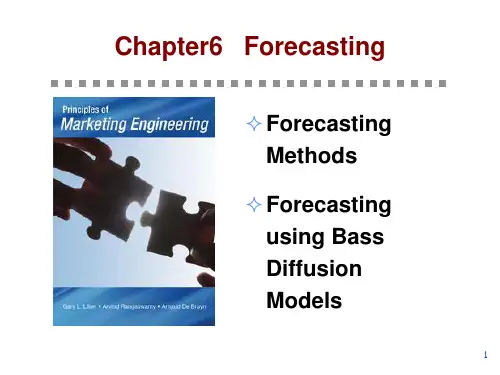

第一部分Eviews基本操作第一章预备知识一、什么是Eviews(全称Econometric Views)Eviews 软件是QMS(Quantitative Micro Software)公司开发的基于Windows平台下的应用软件,其前身是DOS操作系统下的TSP软件,最新版本是Eviews6.0。
该软件是由经济学家开发,主要应用在经济学领域,可用于回归分析与预测(regression and forecasting)、时间序列(Time series)以及横截面数据(cross-sectional data )分析。
与其他统计软件(如EXCEL、SAS、SPSS)相比,Eviews功能优势是回归分析与预测。
二、Eviews工作特点初学者需牢记以下两点。
一、Eviews软件对对象(objects)的具体操作是在Workfile 中进行,也就是说,如果想用Eviews进行具体的操作,必须先新建一个或打开一个已经存在在硬盘(或软盘)上的Workfile,在此Workfile中进行输入数据、建造模型等操作;二、Eviews处理的对象及运行结果都称之为objects,如序列(sereis)方程(equations)、模型(models)、系数(coefficients)等objects。
objects可以不同形式浏览(views),比如表格(spreadsheet)、图(graph)、描述统计(descriptive statistics)等,但这些浏览(views)不是独立的objects,他们随原变量序列(views)的改变而改变。
如果想将某个浏览(views)转换成一个独立的objects,可使用freeze 按钮将该views“冻结”,从而形成一个独立的objects,然后可对其进行编辑或存储。
三、一个作示例在这里,我们通过一个简单的回归分析例子来显示一个Eviews过程,不对Eviews的功能展开讨论,目的是使读者先对Eviews有个概括了解。
population 母体sample 样本census 普查sampling 抽样quantitative 量的qualitative/categorical质的discrete 离散的continuous 连续的population parameters 母体参数sample statistics 样本统计量descriptive statistics 叙述统计学inferential/inductive statistics 推论 ...抽样调查(sampliing survey单纯随机抽样(simple random sampling 系统抽样(systematic sampling分层抽样(stratified sampling整群抽样(cluster sampling多级抽样(multistage sampling常态分配(Parametric Statistics)无母数统计学(Nonparametric Statistics) 实验设计(Design of Experiment)参数(Parameter)Data analysis 资料分析Statistical table 统计表Statistical chart 统计图Pie chart 圆饼图Stem-and-leaf display 茎叶图Box plot 盒须图Histogram 直方图Bar Chart 长条图Polygon 次数多边图Ogive 肩形图Descriptive statistics 叙述统计学Expectation 期望值Mode 众数Mean 平均数Variance 变异数Standard deviation 标准差Standard error 标准误Covariance matrix 共变异数矩阵Inferential statistics 推论统计学Point estimation 点估计Interval estimation 区间估计Confidence interval 信赖区间Confidence coefficient 信赖系数Testing statistical hypothesis 统计假设检定Regression analysis 回归分析Analysis of variance 变异数分析Correlation coefficient 相关系数Sampling survey 抽样调查Census 普查Sampling 抽样Reliability 信度Validity 效度Sampling error 抽样误差Non-sampling error 非抽样误差Random sampling 随机抽样Simple random sampling 简单随机抽样法Stratified sampling 分层抽样法Cluster sampling 群集抽样法Systematic sampling 系统抽样法Two-stage random sampling 两段随机抽样法Convenience sampling 便利抽样Quota sampling 配额抽样Snowball sampling 雪球抽样Nonparametric statistics 无母数统计The sign test 等级检定Wilcoxon signed rank tests 魏克森讯号等级检定Wilcoxon rank sum tests 魏克森等级和检定Run test 连检定法Discrete uniform densities 离散的均匀密度Binomial densities 二项密度Hypergeometric densities 超几何密度Poisson densities 卜松密度Geometric densities 几何密度Negative binomial densities 负二项密度Continuous uniform densities 连续均匀密度Normal densities 常态密度Exponential densities 指数密度Gamma densities 伽玛密度Beta densities 贝他密度Multivariate analysis 多变量分析Principal components 主因子分析Discrimination analysis 区别分析Cluster analysis 群集分析Factor analysis 因素分析Survival analysis 存活分析Time series analysis 时间序列分析Linear models 线性模式Quality engineering 品质工程Probability theory 机率论Statistical computing 统计计算Statistical inference 统计推论Stochastic processes 随机过程Decision theory 决策理论Discrete analysis 离散分析Mathematical statistics 数理统计统计学: Statistics母体: Population样本: Sample资料分析: Data analysis统计表: Statistical table统计图: Statistical chart圆饼图: Pie chart茎叶图: Stem-and-leaf display盒须图: Box plot直方图: Histogram长条图: Bar Chart次数多边图: Polygon肩形图: Ogive叙述统计学: Descriptive statistics 期望值: Expectation众数: Mode平均数: Mean变异数: Variance标准差: Standard deviation标准误: Standard error共变异数矩阵: Covariance matrix推论统计学: Inferential statistics点估计: Point estimation区间估计: Interval estimation信赖区间: Confidence interval信赖系数: Confidence coefficient统计假设检定: Testing statisticalhypothesis回归分析: Regression analysis变异数分析: Analysis of variance相关系数: Correlation coefficient抽样调查: Sampling survey普查: Census抽样: Sampling信度: Reliability效度: Validity抽样误差: Sampling error非抽样误差: Non-sampling error随机抽样: Random sampling简单随机抽样法: Simple randomsampling分层抽样法: Stratified sampling群集抽样法: Cluster sampling系统抽样法: Systematic sampling两段随机抽样法: Two-stage randomsampling便利抽样: Convenience sampling配额抽样: Quota sampling雪球抽样: Snowball sampling无母数统计: Nonparametric statistics等级检定: The sign test魏克森讯号等级检定: Wilcoxon signedrank tests魏克森等级和检定: Wilcoxon rank sumtests连检定法: Run test离散的均匀密度: Discrete uniformdensities二项密度: Binomial densities超几何密度: Hypergeometric densities卜松密度: Poisson densities几何密度: Geometric densities负二项密度: Negative binomial densities连续均匀密度: Continuous uniformdensities常态密度: Normal densities指数密度: Exponential densities伽玛密度: Gamma densities贝他密度: Beta densities多变量分析: Multivariate analysis主因子分析: Principal components区别分析: Discrimination analysis群集分析: Cluster analysis因素分析: Factor analysis存活分析: Survival analysis时间序列分析: Time series analysis线性模式: Linear models品质工程: Quality engineering机率论: Probability theory统计计算: Statistical computing统计推论: Statistical inference随机过程: Stochastic processes决策理论: Decision theory离散分析: Discrete analysis数理统计: Mathematical statistics统计名词市调辞典众数(Mode) 普查(census)指数(Index) 问卷(Questionnaire)中位数(Median) 信度(Reliability)百分比(Percentage) 母群体(Population)信赖水准(Confidence level) 观察法(Observational Survey)假设检定(Hypothesis Testing) 综合法(Integrated Survey)卡方检定(Chi-square Test) 雪球抽样(Snowball Sampling)差距量表(Interval Scale) 序列偏差(Series Bias)类别量表(Nominal Scale) 次级资料(Secondary Data)顺序量表(Ordinal Scale) 抽样架构(Sampling frame)比率量表(Ratio Scale) 集群抽样(Cluster Sampling)连检定法(Run Test) 便利抽样(Convenience Sampling)符号检定(Sign Test) 抽样调查(SamplingSur)算术平均数(Arithmetic Mean) 非抽样误差(non-sampling error)展示会法(Display Survey)调查名词准确效度(Criterion-RelatedValidity)元素(Element) 邮寄问卷法(Mail Interview)样本(Sample) 信抽样误差(Sampling error)效度(Validity) 封闭式问题(Close Question)精确度(Precision) 电话访问法(TelephoneInterview)准确度(Validity) 随机抽样法(RandomSampling)实验法(Experiment Survey)抽样单位(Sampling unit) 资讯名词市场调查(Marketing Research) 决策树(Decision Trees)容忍误差(Tolerated erro) 资料采矿(DataMining)初级资料(Primary Data) 时间序列(Time-Series Forecasting)目标母体(Target Population) 回归分析(Regression)抽样偏差(Sampling Bias) 趋势分析(TrendAnalysis)抽样误差(sampling error) 罗吉斯回归(Logistic Regression)架构效度(Construct Validity) 类神经网络(Neural Network)配额抽样(Quota Sampling) 无母数统计检定方法(Non-Parametric Test)人员访问法(Interview) 判别分析法(Discriminant Analysis)集群分析法(cluster analysis) 规则归纳法(Rules Induction)内容效度(Content Validity) 判断抽样(Judgment Sampling)开放式问题(Open Question) OLAP(OnlineAnalytical Process)分层随机抽样(Stratified Randomsampling) 资料仓储(Data Warehouse)非随机抽样法(Nonrandom Sampling) 知识发现(Knowledge DiscoveryAbsolute deviation, 绝对离差Absolute number, 绝对数Absolute residuals, 绝对残差Acceleration array, 加速度立体阵Acceleration in an arbitrary direction, 任意方向上的加速度Acceleration normal, 法向加速度Acceleration space dimension, 加速度空间的维数Acceleration tangential, 切向加速度Acceleration vector, 加速度向量Acceptable hypothesis, 可接受假设Accumulation, 累积Accuracy, 准确度Actual frequency, 实际频数Adaptive estimator, 自适应估计量Addition, 相加Addition theorem, 加法定理Additive Noise, 加性噪声Additivity, 可加性Adjusted rate, 调整率Adjusted value, 校正值Admissible error, 容许误差Aggregation, 聚集性Alpha factoring,α因子法Alternative hypothesis, 备择假设Among groups, 组间Amounts, 总量Analysis of correlation, 相关分析Analysis of covariance, 协方差分析Analysis Of Effects, 效应分析Analysis Of Variance, 方差分析Analysis of regression, 回归分析Analysis of time series, 时间序列分析Analysis of variance, 方差分析Angular transformation, 角转换ANOVA (analysis of variance), 方差分析ANOVA Models, 方差分析模型ANOVA table and eta, 分组计算方差分析Arcing, 弧/弧旋Arcsine transformation, 反正弦变换Area 区域图Area under the curve, 曲线面积AREG , 评估从一个时间点到下一个时间点回归相关时的误差ARIMA, 季节和非季节性单变量模型的极大似然估计Arithmetic grid paper, 算术格纸Arithmetic mean, 算术平均数Arrhenius relation, 艾恩尼斯关系Assessing fit, 拟合的评估Associative laws, 结合律Asymmetric distribution, 非对称分布Asymptotic bias, 渐近偏倚Asymptotic efficiency, 渐近效率Asymptotic variance, 渐近方差Attributable risk, 归因危险度Attribute data, 属性资料Attribution, 属性Autocorrelation, 自相关Autocorrelation of residuals, 残差的自相关Average, 平均数Average confidence interval length, 平均置信区间长度Average growth rate, 平均增长率Bar chart, 条形图Bar graph, 条形图Base period, 基期Bayes' theorem , Bayes定理Bell-shaped curve, 钟形曲线Bernoulli distribution, 伯努力分布Best-trim estimator, 最好切尾估计量Bias, 偏性Binary logistic regression, 二元逻辑斯蒂回归Binomial distribution, 二项分布Bisquare, 双平方Bivariate Correlate, 二变量相关Bivariate normal distribution, 双变量正态分布Bivariate normal population, 双变量正态总体Biweight interval, 双权区间Biweight M-estimator, 双权M估计量Block, 区组/配伍组BMDP(Biomedical computer programs),BMDP统计软件包Boxplots, 箱线图/箱尾图Breakdown bound, 崩溃界/崩溃点Canonical correlation, 典型相关Caption, 纵标目Case-control study, 病例对照研究Categorical variable, 分类变量Catenary, 悬链线Cauchy distribution, 柯西分布Cause-and-effect relationship, 因果关系Cell, 单元Censoring, 终检Center of symmetry, 对称中心Centering and scaling, 中心化和定标Central tendency, 集中趋势Central value, 中心值CHAID -χ2 Automatic Interaction Detector,卡方自动交互检测Chance, 机遇Chance error, 随机误差Chance variable, 随机变量Characteristic equation, 特征方程Characteristic root, 特征根Characteristic vector, 特征向量Chebshev criterion of fit, 拟合的切比雪夫准则Chernoff faces, 切尔诺夫脸谱图Chi-square test, 卡方检验/χ2检验Choleskey decomposition, 乔洛斯基分解Circle chart, 圆图Class interval, 组距Class mid-value, 组中值Class upper limit, 组上限Classified variable, 分类变量Cluster analysis, 聚类分析Cluster sampling, 整群抽样Code, 代码Coded data, 编码数据Coding, 编码Coefficient of contingency, 列联系数Coefficient of determination, 决定系数Coefficient of multiple correlation, 多重相关系数Coefficient of partial correlation, 偏相关系数Coefficient of production-moment correlation, 积差相关系数Coefficient of rank correlation, 等级相关系数Coefficient of regression, 回归系数Coefficient of skewness, 偏度系数Coefficient of variation, 变异系数Cohort study, 队列研究Collinearity, 共线性Column, 列Column effect, 列效应Column factor, 列因素Combination pool, 合并Combinative table, 组合表Common factor, 共性因子Common regression coefficient, 公共回归系数Common value, 共同值Common variance, 公共方差Common variation, 公共变异Communality variance, 共性方差Comparability, 可比性Comparison of bathes, 批比较Comparison value, 比较值Compartment model, 分部模型Compassion, 伸缩Complement of an event, 补事件Complete association, 完全正相关Complete dissociation, 完全不相关Complete statistics, 完备统计量Completely randomized design, 完全随机化设计Composite event, 联合事件Composite events, 复合事件Concavity, 凹性Conditional expectation, 条件期望Conditional likelihood, 条件似然Conditional probability, 条件概率Conditionally linear, 依条件线性Confidence interval, 置信区间Confidence limit, 置信限Confidence lower limit, 置信下限Confidence upper limit, 置信上限Confirmatory Factor Analysis , 验证性因子分析Confirmatory research, 证实性实验研究Confounding factor, 混杂因素Conjoint, 联合分析Consistency, 相合性Consistency check, 一致性检验Consistent asymptotically normal estimate,相合渐近正态估计Consistent estimate, 相合估计Constrained nonlinear regression, 受约束非线性回归Constraint, 约束Contaminated distribution, 污染分布Contaminated Gausssian, 污染高斯分布Contaminated normal distribution, 污染正态分布Contamination, 污染Contamination model, 污染模型Contingency table, 列联表Contour, 边界线Contribution rate, 贡献率Control, 对照, 质量控制图Controlled experiments, 对照实验Conventional depth, 常规深度Convolution, 卷积Corrected factor, 校正因子Corrected mean, 校正均值Correction coefficient, 校正系数Correctness, 正确性Correlation coefficient, 相关系数Correlation, 相关性Correlation index, 相关指数Correspondence, 对应Counting, 计数Counts, 计数/频数Covariance, 协方差Covariant, 共变Cox Regression, Cox回归Criteria for fitting, 拟合准则Criteria of least squares, 最小二乘准则Critical ratio, 临界比Critical region, 拒绝域Critical value, 临界值Cross-over design, 交叉设计Cross-section analysis, 横断面分析Cross-section survey, 横断面调查Crosstabs , 交叉表Crosstabs 列联表分析Cross-tabulation table, 复合表Cube root, 立方根Cumulative distribution function, 分布函数Cumulative probability, 累计概率Curvature, 曲率/弯曲Curvature, 曲率Curve Estimation, 曲线拟合Curve fit , 曲线拟和Curve fitting, 曲线拟合Curvilinear regression, 曲线回归Curvilinear relation, 曲线关系Cut-and-try method, 尝试法Cycle, 周期Cyclist, 周期性D test, D检验Data acquisition, 资料收集Data bank, 数据库Data capacity, 数据容量Data deficiencies, 数据缺乏Data handling, 数据处理Data manipulation, 数据处理Data processing, 数据处理Data reduction, 数据缩减Data set, 数据集Data sources, 数据来源Data transformation, 数据变换Data validity, 数据有效性Data-in, 数据输入Data-out, 数据输出Dead time, 停滞期Degree of freedom, 自由度Degree of precision, 精密度Degree of reliability, 可靠性程度Degression, 递减Density function, 密度函数Density of data points, 数据点的密度Dependent variable, 应变量/依变量/因变量Dependent variable, 因变量Depth, 深度Derivative matrix, 导数矩阵Derivative-free methods, 无导数方法Design, 设计Determinacy, 确定性Determinant, 行列式Determinant, 决定因素Deviation, 离差Deviation from average, 离均差Diagnostic plot, 诊断图Dichotomous variable, 二分变量Differential equation, 微分方程Direct standardization, 直接标准化法Direct Oblimin, 斜交旋转Discrete variable, 离散型变量DISCRIMINANT, 判断Discriminant analysis, 判别分析Discriminant coefficient, 判别系数Discriminant function, 判别值Dispersion, 散布/分散度Disproportional, 不成比例的Disproportionate sub-class numbers, 不成比例次级组含量Distribution free, 分布无关性/免分布Distribution shape, 分布形状Distribution-free method, 任意分布法Distributive laws, 分配律Disturbance, 随机扰动项Dose response curve, 剂量反应曲线Double blind method, 双盲法Double blind trial, 双盲试验Double exponential distribution, 双指数分布Double logarithmic, 双对数Downward rank, 降秩Dual-space plot, 对偶空间图DUD, 无导数方法Duncan's new multiple range method, 新复极差法/Duncan新法Error Bar, 均值相关区间图Effect, 实验效应Eigenvalue, 特征值Eigenvector, 特征向量Ellipse, 椭圆Empirical distribution, 经验分布Empirical probability, 经验概率单位Enumeration data, 计数资料Equal sun-class number, 相等次级组含量Equally likely, 等可能Equivariance, 同变性Error, 误差/错误Error of estimate, 估计误差Error type I, 第一类错误Error type II, 第二类错误Estimand, 被估量Estimated error mean squares, 估计误差均方Estimated error sum of squares, 估计误差平方和Euclidean distance, 欧式距离Event, 事件Event, 事件Exceptional data point, 异常数据点Expectation plane, 期望平面Expectation surface, 期望曲面Expected values, 期望值Experiment, 实验Experimental sampling, 试验抽样Experimental unit, 试验单位Explained variance (已说明方差)Explanatory variable, 说明变量Exploratory data analysis, 探索性数据分析Explore Summarize, 探索-摘要Exponential curve, 指数曲线Exponential growth, 指数式增长EXSMOOTH, 指数平滑方法Extended fit, 扩充拟合Extra parameter, 附加参数Extrapolation, 外推法Extreme observation, 末端观测值Extremes, 极端值/极值F distribution, F分布F test, F检验Factor, 因素/因子Factor analysis, 因子分析Factor Analysis, 因子分析Factor score, 因子得分Factorial, 阶乘Factorial design, 析因试验设计False negative, 假阴性False negative error, 假阴性错误Family of distributions, 分布族Family of estimators, 估计量族Fanning, 扇面Fatality rate, 病死率Field investigation, 现场调查Field survey, 现场调查Finite population, 有限总体Finite-sample, 有限样本First derivative, 一阶导数First principal component, 第一主成分First quartile, 第一四分位数Fisher information, 费雪信息量Fitted value, 拟合值Fitting a curve, 曲线拟合Fixed base, 定基Fluctuation, 随机起伏Forecast, 预测Four fold table, 四格表Fourth, 四分点Fraction blow, 左侧比率Fractional error, 相对误差Frequency, 频率Frequency polygon, 频数多边图Frontier point, 界限点Function relationship, 泛函关系Gamma distribution, 伽玛分布Gauss increment, 高斯增量Gaussian distribution, 高斯分布/正态分布Gauss-Newton increment, 高斯-牛顿增量General census, 全面普查Generalized least squares, 综合最小平方法GENLOG (Generalized liner models), 广义线性模型Geometric mean, 几何平均数Gini's mean difference, 基尼均差GLM (General liner models), 通用线性模型Goodness of fit, 拟和优度/配合度Gradient of determinant, 行列式的梯度Graeco-Latin square, 希腊拉丁方Grand mean, 总均值Gross errors, 重大错误Gross-error sensitivity, 大错敏感度Group averages, 分组平均Grouped data, 分组资料Guessed mean, 假定平均数Half-life, 半衰期Hampel M-estimators, 汉佩尔M估计量Happenstance, 偶然事件Harmonic mean, 调和均数Hazard function, 风险均数Hazard rate, 风险率Heading, 标目Heavy-tailed distribution, 重尾分布Hessian array, 海森立体阵Heterogeneity, 不同质Heterogeneity of variance, 方差不齐Hierarchical classification, 组内分组Hierarchical clustering method, 系统聚类法High-leverage point, 高杠杆率点High-Low, 低区域图Higher Order Interaction Effects,高阶交互作用HILOGLINEAR, 多维列联表的层次对数线性模型Hinge, 折叶点Histogram, 直方图Historical cohort study, 历史性队列研究Holes, 空洞HOMALS, 多重响应分析Homogeneity of variance, 方差齐性Homogeneity test, 齐性检验Huber M-estimators, 休伯M估计量Hyperbola, 双曲线Hypothesis testing, 假设检验Hypothetical universe, 假设总体Image factoring,, 多元回归法Impossible event, 不可能事件Independence, 独立性Independent variable, 自变量Index, 指标/指数Indirect standardization, 间接标准化法Individual, 个体Inference band, 推断带Infinite population, 无限总体Infinitely great, 无穷大Infinitely small, 无穷小Influence curve, 影响曲线Information capacity, 信息容量Initial condition, 初始条件Initial estimate, 初始估计值Initial level, 最初水平Interaction, 交互作用Interaction terms, 交互作用项Intercept, 截距Interpolation, 内插法Interquartile range, 四分位距Interval estimation, 区间估计Intervals of equal probability, 等概率区间Intrinsic curvature, 固有曲率Invariance, 不变性Inverse matrix, 逆矩阵Inverse probability, 逆概率Inverse sine transformation, 反正弦变换Iteration, 迭代Jacobian determinant, 雅可比行列式Joint distribution function, 分布函数Joint probability, 联合概率Joint probability distribution, 联合概率分布K-Means Cluster逐步聚类分析K means method, 逐步聚类法Kaplan-Meier, 评估事件的时间长度Kaplan-Merier chart, Kaplan-Merier图Kendall's rank correlation, Kendall等级相关Kinetic, 动力学Kolmogorov-Smirnove test, 柯尔莫哥洛夫-斯米尔诺夫检验Kruskal and Wallis test, Kruskal及Wallis检验/多样本的秩和检验/H检验Kurtosis, 峰度Lack of fit, 失拟Ladder of powers, 幂阶梯Lag, 滞后Large sample, 大样本Large sample test, 大样本检验Latin square, 拉丁方Latin square design, 拉丁方设计Leakage, 泄漏Least favorable configuration, 最不利构形Least favorable distribution, 最不利分布Least significant difference, 最小显著差法Least square method, 最小二乘法Least Squared Criterion,最小二乘方准则Least-absolute-residuals estimates, 最小绝对残差估计Least-absolute-residuals fit, 最小绝对残差拟合Least-absolute-residuals line, 最小绝对残差线Legend, 图例L-estimator, L估计量L-estimator of location, 位置L估计量L-estimator of scale, 尺度L估计量Level, 水平Leveage Correction,杠杆率校正Life expectance, 预期期望寿命Life table, 寿命表Life table method, 生命表法Light-tailed distribution, 轻尾分布Likelihood function, 似然函数Likelihood ratio, 似然比line graph, 线图Linear correlation, 直线相关Linear equation, 线性方程Linear programming, 线性规划Linear regression, 直线回归Linear Regression, 线性回归Linear trend, 线性趋势Loading, 载荷Location and scale equivariance, 位置尺度同变性Location equivariance, 位置同变性Location invariance, 位置不变性Location scale family, 位置尺度族Log rank test, 时序检验Logarithmic curve, 对数曲线Logarithmic normal distribution, 对数正态分布Logarithmic scale, 对数尺度Logarithmic transformation, 对数变换Logic check, 逻辑检查Logistic distribution, 逻辑斯特分布Logit transformation, Logit转换LOGLINEAR, 多维列联表通用模型Lognormal distribution, 对数正态分布Lost function, 损失函数Low correlation, 低度相关Lower limit, 下限Lowest-attained variance, 最小可达方差LSD, 最小显著差法的简称Lurking variable, 潜在变量Main effect, 主效应Major heading, 主辞标目Marginal density function, 边缘密度函数Marginal probability, 边缘概率Marginal probability distribution, 边缘概率分布Matched data, 配对资料Matched distribution, 匹配过分布Matching of distribution, 分布的匹配Matching of transformation, 变换的匹配Mathematical expectation, 数学期望Mathematical model, 数学模型Maximum L-estimator, 极大极小L 估计量Maximum likelihood method, 最大似然法Mean, 均数Mean squares between groups, 组间均方Mean squares within group, 组内均方Means (Compare means), 均值-均值比较Median, 中位数Median effective dose, 半数效量Median lethal dose, 半数致死量Median polish, 中位数平滑Median test, 中位数检验Minimal sufficient statistic, 最小充分统计量Minimum distance estimation, 最小距离估计Minimum effective dose, 最小有效量Minimum lethal dose, 最小致死量Minimum variance estimator, 最小方差估计量MINITAB, 统计软件包Minor heading, 宾词标目Missing data, 缺失值Model specification, 模型的确定Modeling Statistics , 模型统计Models for outliers, 离群值模型Modifying the model, 模型的修正Modulus of continuity, 连续性模Morbidity, 发病率Most favorable configuration, 最有利构形MSC(多元散射校正)Multidimensional Scaling (ASCAL), 多维尺度/多维标度Multinomial Logistic Regression , 多项逻辑斯蒂回归Multiple comparison, 多重比较Multiple correlation , 复相关Multiple covariance, 多元协方差Multiple linear regression, 多元线性回归Multiple response , 多重选项Multiple solutions, 多解Multiplication theorem, 乘法定理Multiresponse, 多元响应Multi-stage sampling, 多阶段抽样Multivariate T distribution, 多元T分布Mutual exclusive, 互不相容Mutual independence, 互相独立Natural boundary, 自然边界Natural dead, 自然死亡Natural zero, 自然零Negative correlation, 负相关Negative linear correlation, 负线性相关Negatively skewed, 负偏Newman-Keuls method, q检验NK method, q检验No statistical significance, 无统计意义Nominal variable, 名义变量Nonconstancy of variability, 变异的非定常性Nonlinear regression, 非线性相关Nonparametric statistics, 非参数统计Nonparametric test, 非参数检验Nonparametric tests, 非参数检验Normal deviate, 正态离差Normal distribution, 正态分布Normal equation, 正规方程组Normal P-P, 正态概率分布图Normal Q-Q, 正态概率单位分布图Normal ranges, 正常范围Normal value, 正常值Normalization 归一化Nuisance parameter, 多余参数/讨厌参数Null hypothesis, 无效假设Numerical variable, 数值变量Objective function, 目标函数Observation unit, 观察单位Observed value, 观察值One sided test, 单侧检验One-way analysis of variance, 单因素方差分析Oneway ANOVA , 单因素方差分析Open sequential trial, 开放型序贯设计Optrim, 优切尾Optrim efficiency, 优切尾效率Order statistics, 顺序统计量Ordered categories, 有序分类Ordinal logistic regression , 序数逻辑斯蒂回归Ordinal variable, 有序变量Orthogonal basis, 正交基Orthogonal design, 正交试验设计Orthogonality conditions, 正交条件ORTHOPLAN, 正交设计Outlier cutoffs, 离群值截断点Outliers, 极端值OVERALS , 多组变量的非线性正规相关Overshoot, 迭代过度Paired design, 配对设计Paired sample, 配对样本Pairwise slopes, 成对斜率Parabola, 抛物线Parallel tests, 平行试验Parameter, 参数Parametric statistics, 参数统计Parametric test, 参数检验Pareto, 直条构成线图(又称佩尔托图)Partial correlation, 偏相关Partial regression, 偏回归Partial sorting, 偏排序Partials residuals, 偏残差Pattern, 模式PCA(主成分分析)Pearson curves, 皮尔逊曲线Peeling, 退层Percent bar graph, 百分条形图Percentage, 百分比Percentile, 百分位数Percentile curves, 百分位曲线Periodicity, 周期性Permutation, 排列P-estimator, P估计量Pie graph, 构成图,饼图Pitman estimator, 皮特曼估计量Pivot, 枢轴量Planar, 平坦Planar assumption, 平面的假设PLANCARDS, 生成试验的计划卡PLS(偏最小二乘法)Point estimation, 点估计Poisson distribution, 泊松分布Polishing, 平滑Polled standard deviation, 合并标准差Polled variance, 合并方差Polygon, 多边图Polynomial, 多项式Polynomial curve, 多项式曲线Population, 总体Population attributable risk, 人群归因危险度Positive correlation, 正相关Positively skewed, 正偏Posterior distribution, 后验分布Power of a test, 检验效能Precision, 精密度Predicted value, 预测值Preliminary analysis, 预备性分析Principal axis factoring,主轴因子法Principal component analysis, 主成分分析Prior distribution, 先验分布Prior probability, 先验概率Probabilistic model, 概率模型probability, 概率Probability density, 概率密度Product moment, 乘积矩/协方差Profile trace, 截面迹图Proportion, 比/构成比Proportion allocation in stratified randomsampling, 按比例分层随机抽样Proportionate, 成比例Proportionate sub-class numbers, 成比例次级组含量Prospective study, 前瞻性调查Proximities, 亲近性Pseudo F test, 近似F检验Pseudo model, 近似模型Pseudosigma, 伪标准差Purposive sampling, 有目的抽样QR decomposition, QR分解Quadratic approximation, 二次近似Qualitative classification, 属性分类Qualitative method, 定性方法Quantile-quantile plot, 分位数-分位数图/Q-Q 图Quantitative analysis, 定量分析Quartile, 四分位数Quick Cluster, 快速聚类Radix sort, 基数排序Random allocation, 随机化分组Random blocks design, 随机区组设计Random event, 随机事件Randomization, 随机化Range, 极差/全距Rank correlation, 等级相关Rank sum test, 秩和检验Rank test, 秩检验Ranked data, 等级资料Rate, 比率Ratio, 比例Raw data, 原始资料Raw residual, 原始残差Rayleigh's test, 雷氏检验Rayleigh's Z, 雷氏Z值Reciprocal, 倒数Reciprocal transformation, 倒数变换Recording, 记录Redescending estimators, 回降估计量Reducing dimensions, 降维Re-expression, 重新表达Reference set, 标准组Region of acceptance, 接受域Regression coefficient, 回归系数Regression sum of square, 回归平方和Rejection point, 拒绝点Relative dispersion, 相对离散度Relative number, 相对数Reliability, 可靠性Reparametrization, 重新设置参数Replication, 重复Report Summaries, 报告摘要Residual sum of square, 剩余平方和residual variance (剩余方差)Resistance, 耐抗性Resistant line, 耐抗线Resistant technique, 耐抗技术R-estimator of location, 位置R估计量R-estimator of scale, 尺度R估计量Retrospective study, 回顾性调查Ridge trace, 岭迹Ridit analysis, Ridit分析Rotation, 旋转Rounding, 舍入Row, 行Row effects, 行效应Row factor, 行因素RXC table, RXC表Sample, 样本Sample regression coefficient, 样本回归系数Sample size, 样本量Sample standard deviation, 样本标准差Sampling error, 抽样误差SAS(Statistical analysis system ), SAS统计软件包Scale, 尺度/量表Scatter diagram, 散点图Schematic plot, 示意图/简图Score test, 计分检验Screening, 筛检SEASON, 季节分析Second derivative, 二阶导数Second principal component, 第二主成分SEM (Structural equation modeling), 结构化方程模型Semi-logarithmic graph, 半对数图Semi-logarithmic paper, 半对数格纸Sensitivity curve, 敏感度曲线Sequential analysis, 贯序分析Sequence, 普通序列图Sequential data set, 顺序数据集Sequential design, 贯序设计Sequential method, 贯序法Sequential test, 贯序检验法Serial tests, 系列试验Short-cut method, 简捷法Sigmoid curve, S形曲线Sign function, 正负号函数Sign test, 符号检验Signed rank, 符号秩Significant Level, 显著水平Significance test, 显著性检验Significant figure, 有效数字Simple cluster sampling, 简单整群抽样Simple correlation, 简单相关Simple random sampling, 简单随机抽样Simple regression, 简单回归simple table, 简单表Sine estimator, 正弦估计量Single-valued estimate, 单值估计Singular matrix, 奇异矩阵Skewed distribution, 偏斜分布Skewness, 偏度Slash distribution, 斜线分布Slope, 斜率Smirnov test, 斯米尔诺夫检验Source of variation, 变异来源Spearman rank correlation, 斯皮尔曼等级相关Specific factor, 特殊因子Specific factor variance, 特殊因子方差Spectra , 频谱Spherical distribution, 球型正态分布Spread, 展布SPSS(Statistical package for the social science), SPSS统计软件包Spurious correlation, 假性相关Square root transformation, 平方根变换Stabilizing variance, 稳定方差Standard deviation, 标准差Standard error, 标准误Standard error of difference, 差别的标准误Standard error of estimate, 标准估计误差Standard error of rate, 率的标准误Standard normal distribution, 标准正态分布Standardization, 标准化Starting value, 起始值Statistic, 统计量Statistical control, 统计控制Statistical graph, 统计图Statistical inference, 统计推断Statistical table, 统计表Steepest descent, 最速下降法Stem and leaf display, 茎叶图Step factor, 步长因子Stepwise regression, 逐步回归Storage, 存Strata, 层(复数)Stratified sampling, 分层抽样Stratified sampling, 分层抽样Strength, 强度Stringency, 严密性Structural relationship, 结构关系Studentized residual, 学生化残差/t化残差Sub-class numbers, 次级组含量Subdividing, 分割Sufficient statistic, 充分统计量Sum of products, 积和Sum of squares, 离差平方和Sum of squares about regression, 回归平方和Sum of squares between groups, 组间平方和Sum of squares of partial regression, 偏回归平方和Sure event, 必然事件Survey, 调查Survival, 生存分析Survival rate, 生存率Suspended root gram, 悬吊根图Symmetry, 对称Systematic error, 系统误差Systematic sampling, 系统抽样Tags, 标签Tail area, 尾部面积Tail length, 尾长Tail weight, 尾重Tangent line, 切线Target distribution, 目标分布Taylor series, 泰勒级数Test(检验)Test of linearity, 线性检验Tendency of dispersion, 离散趋势Testing of hypotheses, 假设检验Theoretical frequency, 理论频数Time series, 时间序列Tolerance interval, 容忍区间Tolerance lower limit, 容忍下限Tolerance upper limit, 容忍上限Torsion, 扰率Total sum of square, 总平方和Total variation, 总变异Transformation, 转换Treatment, 处理Trend, 趋势Trend of percentage, 百分比趋势Trial, 试验Trial and error method, 试错法Tuning constant, 细调常数。
一、统计学基础部分1、《统计学》 David Freedman等著,魏宗舒,施锡铨等译中国统计出版社据说是统计思想讲得最好的一本书,读了部分章节,受益很多。
整本书几乎没有公式,但是讲到了统计思想的精髓。
2、《Mind on statistics(英文版)》机械工业出版社只需要高中的数学水平,统计的扫盲书。
有一句话影响很深:Mathematics as to statistics is somethinglike hammer, nails, wood as to a house, it's just the material andtools but not the house itself。
3、《Mathematical Statistics and Data Analysis(英文版.第二版)》机械工业出版社看了就发现和国内的数理统计树有明显的不同。
这本书理念很好,讲了很多新的东西,把很热门的Bootstrap方法和传统统计在一起讲了。
Amazon上有书评。
4、《Business Statistics a decision making approach(影印版)》中国统计出版社在实务中很实用的东西,虽然往往为数理统计的老师所不屑5、《Understanding Statistics in the behavioral science(影印版)》中国统计出版社和上面那本是一个系列的。
老外的书都挺有意思的6、《探索性数据分析》中国统计出版社和第一本是一个系列的。
大家好好看看陈希儒老先生做的序,可以说是对中国数理统计的一种反思。
二、回归部分1、《应用线性回归》中国统计出版社还是著名的蓝皮书系列,有一定的深度,道理讲得挺透的。
看看里面对于偏回归系数的说明,绝对是大开眼界啊!非常精彩的书2、《Regression Analysis by example (3rd Ed影印版)》这是偶第一本从头到底读完的原版统计书,太好看了。
Eviews 软件简介软件标签: 经济计量经济学分析预测工具,破解版Eviews 软件是QMS(Quantitative Micro Software)公司开发的基于Windows平台下的应用软件,其前身是DOS操作系统下的TSP软件。
该软件是由经济学家开发,主要应用在经济学领域,可用于回归分析与预测(regression and forecasting)、时间序列(Time series)以及横截面数据(cross-sectional data )分析。
与其他统计软件(如EXCEL、SAS、SPSS)相比,Eviews功能优势是回归分析与预测。
EViews 引入了流行的对象概念,操作灵活简便,可采用多种操作方式进行各种计量分析和统计分析,数据管理简单方便。
其主要功能有:(1)采用统一的方式管理数据,通过对象、视图和过程实现对数据的各种操作;(2)输入、扩展和修改时间序列数据或截面数据,依据已有序列按任意复杂的公式生成新的序列;(3)计算描述统计量:相关系数、协方差、自相关系数、互相关系数和直方图;(4)进行T 检验、方差分析、协整检验、Granger 因果检验;(5)执行普通最小二乘法、带有自回归校正的最小二乘法、两阶段最小二乘法和三阶段最小二乘法、非线性最小二乘法、广义矩估计法、ARCH 模型估计法等;(6)对二择一决策模型进行Probit、logit 和Gompit 估计;(7)对联立方程进行线性和非线性的估计;(8)估计和分析向量自回归系统;(9)多项式分布滞后模型的估计;(10)回归方程的预测;(11)模型的求解和模拟;(12)数据库管理;(13)与外部软件进行数据交换。
解压后运行Eviews6.reg注册,Eviews6key.exe注册机来算号破解!。